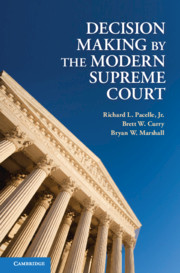Book contents
- Frontmatter
- Contents
- Acknowledgments
- 1 The Supreme Court
- 2 Heuristic Models of Judicial Decision Making
- 3 Building an Integrated Model of Decision Making
- 4 Decision Making on the Modern Supreme Court
- 5 Building a New Legacy
- 6 Sharing the Protection of Minorities
- 7 Avoiding Another Self-Inflicted Wound
- 8 Policing the Boundaries
- 9 Conclusion
- Measurement Appendix
- Cases Cited
- References
- Index
6 - Sharing the Protection of Minorities
Statutory Civil Rights and Individual Liberties
Published online by Cambridge University Press: 05 June 2012
- Frontmatter
- Contents
- Acknowledgments
- 1 The Supreme Court
- 2 Heuristic Models of Judicial Decision Making
- 3 Building an Integrated Model of Decision Making
- 4 Decision Making on the Modern Supreme Court
- 5 Building a New Legacy
- 6 Sharing the Protection of Minorities
- 7 Avoiding Another Self-Inflicted Wound
- 8 Policing the Boundaries
- 9 Conclusion
- Measurement Appendix
- Cases Cited
- References
- Index
Summary
In this chapter, we continue our examination of civil rights and individual liberties but shift our focus to the nonconstitutional decisions. These decisions would be based on a state or federal statute (we concentrate on the latter) rather than constitutional grounds. These cases are salient to the justices, but we argue that the constraints on the Court are much greater. Because these cases are based on statutory grounds, Congress can flip a decision it does not like with a simple majority of both houses. In the last chapter, we saw that the attitudinal variable, issue evolution, and the president were the dominant influences on constitutional civil rights and civil liberties decisions. Precedent did not have an across-the-board impact. Whereas the issues will be similar in content, we expect some significant differences between the constitutional and statutory cases. The latter should be contested on narrower grounds, which should enhance the influence of Congress and precedent. Of course, it is important to remember that the Court has some control over the scope of the issue – it can sometimes decide the case on the grounds it chooses (King 2007). The Court can simply say it is deciding the case on constitutional grounds. Conversely, it can take a case that is being litigated on constitutional ground and redefine it as statutory.
We expect the attitudinal variable to remain important, to be sure, but precedent should emerge as an important factor.
- Type
- Chapter
- Information
- Decision Making by the Modern Supreme Court , pp. 110 - 140Publisher: Cambridge University PressPrint publication year: 2011



